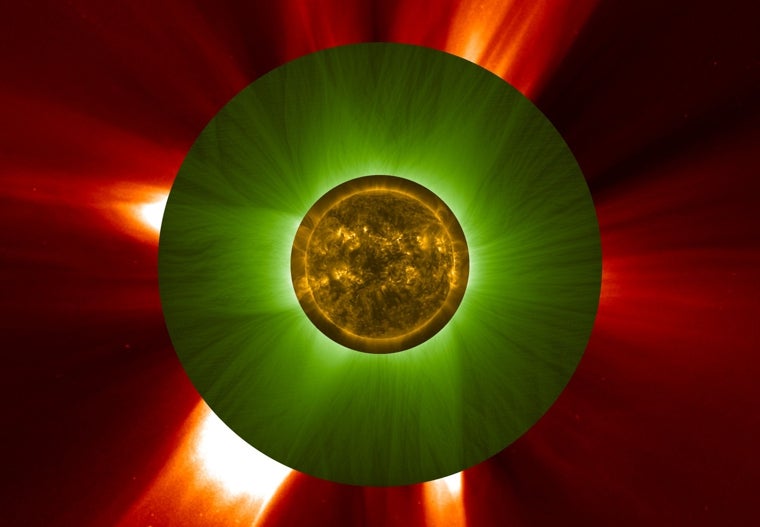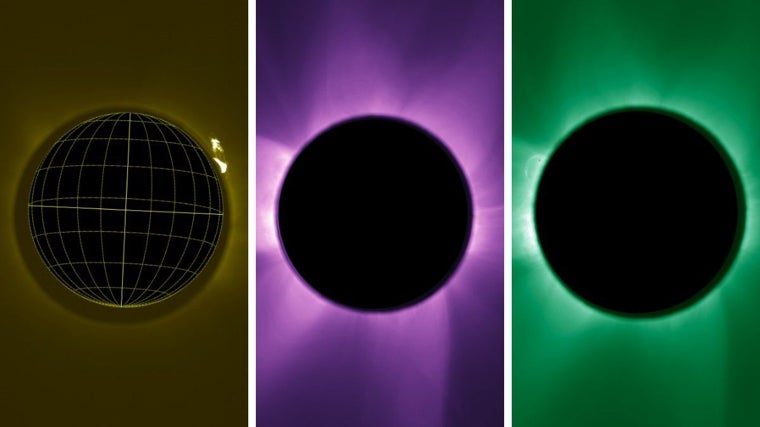First images of a solar eclipse created by two spacecraft in formation

The European Space Agency's (ESA) Proba-3 mission, a Spanish-led technological demonstration, revealed its first images of the Sun's outer atmosphere: the solar corona. The mission's two satellites, capable of flying together in formation as if they were one thanks to a sophisticated set of onboard positioning technologies, have managed to create their first "artificial total solar eclipses" in orbit 60,000 km above Earth. These eclipses are similar to natural ones, with the advantage that they can occur once every 19.5 hours instead of once or twice a year and last six hours instead of a few minutes. This allows scientists much more time to study the Sun, with sharper and more detailed images than those obtained by coronagraphs on traditional telescopes on the ground or in space.
Launched in December from India, Coronagraph and Occulter , the two craft the size of a large refrigerator and weighing up to 300 kilos that make up the mission, achieved a feat never before achieved: they flew 150 meters apart in perfect formation for several hours without any ground control. While aligned, the pair maintained their relative position with an accuracy of one millimeter thanks to a suite of innovative navigation and positioning technologies.
"Formation flight between spacecraft has been achieved before, but never with such a large distance between them and such precision," Diego Rodríguez, Director of Science and Space at Sener Aeroespacial, the company responsible for the mission, told ABC. "At the top of each orbit, which is highly elliptical, and without receiving any commands, the two spacecraft search for each other to fly in formation," he explains. In his opinion, it is a scientific and technological milestone in space exploration.
The spacecraft take advantage of this time in formation to create the artificial eclipse. They align themselves with the Sun so that the 1.4-meter-wide disc carrying the occulter casts a 5-cm shadow on the coronagraph's optical instrument, allowing it to study the faint solar corona.
This has allowed scientists to observe the corona for a very long time, something crucial to delving into its mysteries. "Our goal is to study the solar corona, a largely unexplored region about which there are many questions," says Esther Bastida, a systems engineer at the European Space Research and Technology Centre (ESTEC) in the Netherlands. "For example, we want to find out why the surface of the Sun is 6,000°C while the temperature of the corona—which intuitively should be cooler—is over a million degrees. These images can help us understand that," she says.

Furthermore, having so much observing time will also allow researchers to learn more about how the solar wind works, the continuous flow of matter from the Sun into outer space. It is also necessary to understand the workings of coronal mass ejections (CMEs), explosions of particles emitted by the Sun almost daily, especially during periods of high activity. These events, which can create stunning auroras in the night sky, pose serious threats to modern technology. They can disrupt communications, electrical transmission, and navigation systems on Earth, as happened in May 2024.
Proba-3 observes the corona very close to the Sun's surface, something that until now was only possible during natural solar eclipses. Other spacecraft carry coronagraphs on board to study our star's activity, such as NASA and ESA's SOHO (Solar and Heliospheric Observatory) or ESA's Solar Orbiter , but their instruments are limited by the satellite's size and cannot compare with the "giant instrument" that Proba-3's spacecraft form when flying in formation in space. "This reduces the phenomenon of diffraction, which causes sunlight to filter through the occulter and results in less precise images," says Bastida.
 Various images of the solar corona obtained by Proba-3
THAT
Various images of the solar corona obtained by Proba-3
THAT
Probe-3 has already carried out more than twenty eclipses since its launch. It will also conduct other experiments, so over its two-year lifespan, it will spend at least 1,000 hours "occulting" the Sun, which amounts to more than 150 eclipses.
The Proba-3 images were processed by the ASPIICS Science Operations Center (SOC), located at the Royal Observatory of Belgium. There, a dedicated team of scientists and engineers generates operational commands for the coronagraph at the request of the scientific community and shares the resulting observations. Each complete image, covering the area from the occulted Sun to the edge of the field of view, is constructed from three images. The only difference between them is the exposure time, which determines how long the coronagraph aperture is exposed to light. Combining the three images provides a complete view of the corona.
ABC.es



